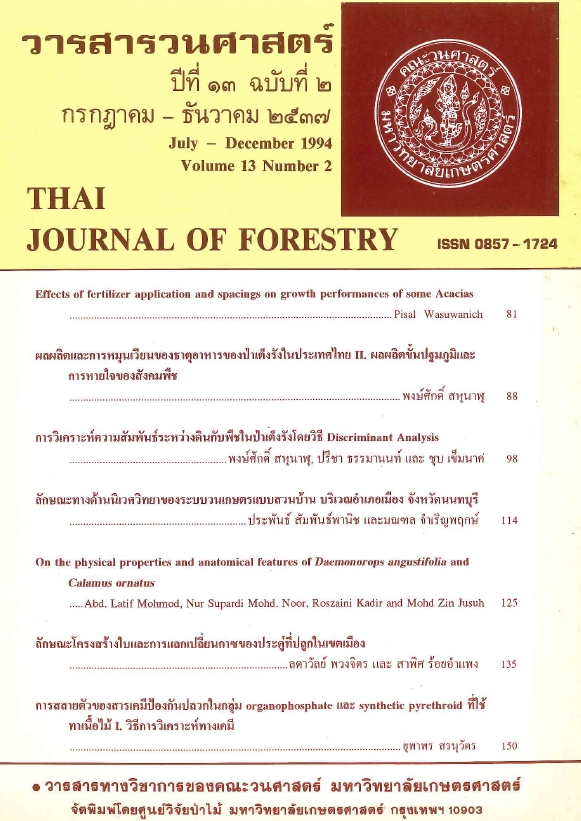การวิเคราะห์ความสัมพันธ์ระหว่างดินกับพืชในป่าเต็งรัง โดยวิธี Discriminant Analysis
Main Article Content
บทคัดย่อ
การศึกษาความสัมพันธ์ระหว่างดินกับพืชในป่าเต็งรังได้ดำเนินการในบริเวณสถานีวิจัยสิ่งแวดล้อมสะแกราช โดยการสุ่มวางแปลงตัวอย่างจำนวน 16 แปลงเป็นตัวแทนของ 16 หมู่ไม้ขนาดแปลงตัวอย่างตะ 2,500 ม2 สำรวจแจงนับไม้ ที่มีขนาดเส้นผ่าศูนย์กลางที่ระดับสูง 1.30 เมตรเหนือพื้นดิน ตั้งแต่ 4.5 ชม.ขึ้นไปทุกต้น วัคขนาคเส้นผ่าศูนย์กลางบันทึกชนิด ขุดดินตัวอย่างแปลงละ 3 หลุม เก็บตัวอย่างดินทุกระดับความลึก ตั้งแต่ 0-5. 10-20, 20-30และ 30-50 ชม. วิเคราะห์ข้อมูลเชิงปริมาณด้านนิเวศวิทยาของพืชพรรณไม้อันได้แก่ ขนาด และพื้นที่หน้าตัดเฉลี่ยมวลชีวภาพเหนือพื้นดินทั้งหมด ความหลากชนิดในรูปแบบต่างๆ ความคล้ายคลึง ระหว่างหมู่ไม้และการจัดกลุ่มวิเคราะห์สมบัติดินในรูปปริมาณการสะสมของอินทรียวัตถุ และธาตุอาหารหลักในชั้นดิน (ลึกถึง 50 ซม.) และศึกษาความสัมพันธ์ระหว่างสมบัติดินที่อยู่ในรูปปริมาณดังกล่าวกับการจัดกลุ่มของหมู่ไม้โคยวิธี Discriminant analysis การศึกษาสรุปได้ว่า พืชพรรณไม้ในป่าเต็งรังสะแกราชนี้มีอยู่ ทั้งสิ้น 46 ชนิด มีการขึ้นกระจายของชนิดแตกต่างกันไปแล้วแต่หมู่ไม้และมีความหลากชนิดต่ำใกล้เคียงกัน สามารถแบ่งกลุ่มตามลักษณะความคล้ายคลึงของหมู่ไม้โดยอาศัยจำนวนชนิดและจำนวนต้นออกเป็น 2-3 กลุ่ม ผลการวิเคราะห์ความสัมพันธ์ระหว่างปริมาณการสะสมของอินทรียวัตถุ และธาตุอาหารในดินกับการจัดกลุ่มของหมู่ไม้แล้วพบว่าปริมาณอินทรียวัตถุและแคลเซียมเป็นปัจจัยสำคัญคือ กลุ่มของหมู่ไม้ที่มีอินทรียวัตถุสะสมอยู่สูง แต่มีแคลเซียมสะสมอยู่ต่ำ จะมีความสูงเฉลี่ย พื้นที่หน้าตัดเฉลี่ย มวลชีวภาพเหนือพื้นดินเฉลี่ย และความหนาแน่นเฉลี่ยสูง แต่มีความหลากชนิดต่ำ ส่วนในกลุ่มของหมู่ไม้ที่มีอินทรียวัตถุสะสมอยู่น้อย แต่มีแคลเซียมสูงจะมีลักษณะในเซิงปริมาณต่าง ๆ ต่ำ แต่มีความหลากชนิดสูง
Downloads
Article Details

อนุญาตภายใต้เงื่อนไข Creative Commons Attribution-NonCommercial-NoDerivatives 4.0 International License.
ข้าพเจ้าและผู้เขียนร่วม (ถ้ามี) ขอรับรองว่า ต้นฉบับที่เสนอมานี้ยังไม่เคยได้รับการตีพิมพ์และไม่ได้อยู่ในระหว่างกระบวนการพิจารณาตีพิมพ์ลงในวารสารหรือสิ่งตีพิมพ์อื่นใด ข้าพเจ้าและผู้เขียนร่วม (ถ้ามี) ยอมรับหลักเกณฑ์และเงื่อนไขการพิจารณาต้นฉบับ ทั้งยินยอมให้กองบรรณาธิการมีสิทธิ์พิจารณาและตรวจแก้ต้นฉบับได้ตามที่เห็นสมควร พร้อมนี้ขอมอบลิขสิทธิ์ผลงานที่ได้รับการตีพิมพ์ให้แก่วารสารวนศาสตร์ คณะวนศาสตร์ มหาวิทยาลัยเกษตรศาสตร์ กรณีมีการฟ้องร้องเรื่องการละเมิดลิขสิทธิ์เกี่ยวกับภาพ กราฟ ข้อความส่วนใดส่วนหนึ่ง หรือ ข้อคิดเห็นที่ปรากฏในผลงาน ให้เป็นความรับผิดชอบของข้าพเจ้าและผู้เขียนร่วม (ถ้ามี) แต่เพียงฝ่ายเดียว และหากข้าพเจ้าและผู้เขียนร่วม (ถ้ามี) ประสงค์ถอนบทความในระหว่างกระบวนการพิจารณาของทางวารสาร ข้าพเจ้าและผู้เขียนร่วม (ถ้ามี) ยินดีรับผิดชอบค่าใช้จ่ายทั้งหมดที่เกิดขึ้นในกระบวนการพิจารณาบทความนั้น”


